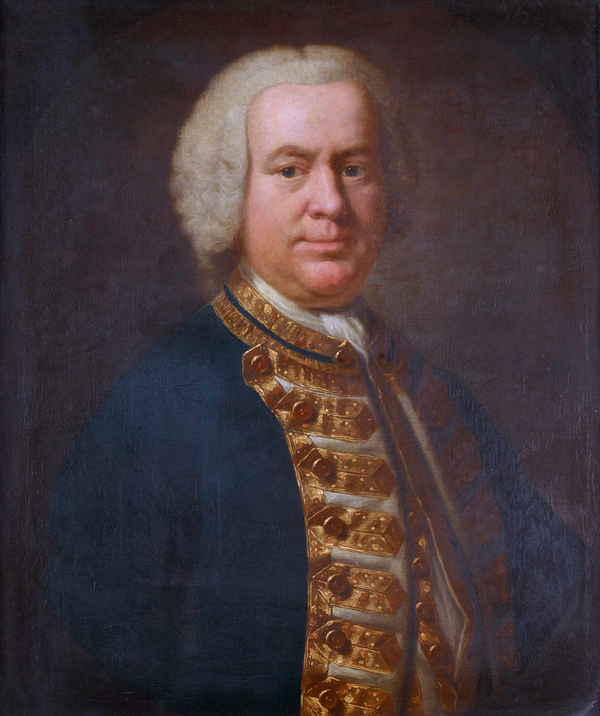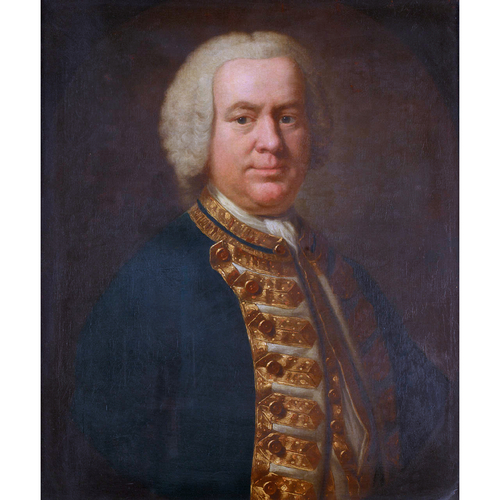
Source: Courtesy of Wikimedia Commons
HOLMES, CHARLES, naval officer; baptized 19 Sept. 1711 at Yarmouth, Isle of Wight, son of the governor of the Isle, Henry Holmes, and Mary Holmes, his cousin; d. 21 Nov. 1761 at Jamaica.
In 1727 Charles Holmes joined the Captain (70 guns) as an ordinary seaman. Promoted lieutenant on 18 June 1734, he served in the Home station and the Mediterranean, and in 1740 went to the West Indies. In 1741 he received his first command, the Strombolo fireship, and then was given the Success fireship, in which he returned to England. On 20 Feb. 1741/42, when he assumed command of the Sapphire (24 guns), he was confirmed in the rank of post captain. In June 1743 he took command of the Enterprise (44 guns) and went to the West Indies. There he became captain of the 70-gun Lennox in May 1747.
He was involved in Sir Charles Knowles’ engagement with the Spanish fleet near Cuba in the fall of 1748. This indecisive action led to a controversy in which Knowles accused several captains, including Holmes, of negligence. A court martial not only acquitted Holmes but praised his conduct.
From 1748 to 1754 Holmes served in home waters. In 1755 he came to North America apparently for the first time when, as captain of the Grafton (74 guns), he sailed in Rear Admiral Francis Holburne’s squadron to reinforce Vice-Admiral Boscawen. The following year he returned to North America as commodore of the squadron charged with preventing French reinforcements from reaching Louisbourg, Île Royale (Cape Breton Island). Two imponderables of 18th century naval warfare – the weather and the health of the seamen – kept his more than adequate force from success. Captain Richard Spry, who commanded the part of the squadron that had wintered in Halifax, was off Louisbourg by May, but was forced off station late in June by the number of seamen disabled and dying from scurvy and dysentery. Holmes reached Nova Scotia on 26 June and, missing Spry in the foggy weather, cruised off Louisbourg until he encountered four French ships under Louis-Joseph Beaussier de Lisle on 26 July. Holmes was out-manœuvred by Beaussier, who entered Louisbourg harbour to land supplies desperately needed by the fortress. After a protracted and indecisive engagement when the French came out to seek battle the following day, Holmes retired to Halifax for repairs. On 10 August Beaussier’s ships sailed safely for France. For the remainder of the season, Holmes’ ships terrorized the French fishery of the Gulf of St Lawrence and Newfoundland.
During his command Holmes had to rely on the limited facilities of Halifax to support his squadron’s insatiable demands. In 1756 naval stores worth over £16,000 were sent to Halifax from England, and between them Holmes and Spry drew on bills of exchange to the value of more than £1,600. Because of the Newcastle administration’s reluctance to pursue an offensive strategy in North America, Holmes was not given authority to create dockyard facilities, and Halifax was little improved as a naval base during his command. As a sop to Governor Charles Lawrence, when Holmes returned to England in October 1756 he left a ship of the line among the warships remaining behind to defend the harbour.
During the winter Holmes was a member of the court martial that convicted Admiral John Byng. He returned to North America with the Grafton in 1757. The ship was among those severely damaged by a hurricane while cruising off Louisbourg on 24 September. Although she had lost her masts and rudder, Holmes, in a superb demonstration of seamanship, sailed her to England with a jury-rudder made of a spare topmast. In 1758 he was employed in home waters and was promoted rear admiral of the blue.
A further promotion, to rear admiral of the white, came to him in 1758 or 1759, possibly on his appointment as third in command under Charles Saunders* for the attack on Quebec. He arrived at Île aux Coudres on 27 June 1759. On 21 July he went above Quebec by land and took command of the ships that under Captain John Rous had slipped past the fortress a few days before. With the Sutherland (50 guns), the Squirrel (20 guns), and a few smaller vessels, Holmes and Brigadier-General James Murray* were able to carry out an extended raid up river from 8 to 25 August, forcing Colonel Bougainville* to maintain an exhausting patrol along the north shore. Although Holmes himself returned down river on 25 August, the threat from the squadron continued until the eve of the final landings and helped deprive Montcalm of Bougainville’s assistance when it was so desperately needed on the Plains of Abraham. On 6 September Holmes accompanied Wolfe up river to prepare for the final assault. The choice of the Anse au Foulon as a landing place compounded the difficulties facing Holmes: he had to guarantee a safe landing in darkness, on a narrow beach, in a tidal current of four knots on the ebbing tide. It was “the most hazardous and difficult task I was ever engaged in,” he wrote. “The failing in any part of my Disposition, as it might overset the Generals plan, would have brought upon me an imputation of being the Cause of the Miscarriage of the Attack. . . .” As it happened, his dispositions were masterly, and his seamen played their part well, although the tide carried their boats a little farther to the east than intended. The enterprise was, according to C. P. Stacey, “a classic of combined operations . . . a professional triumph.”
Late in September Holmes returned to England. In 1760 he was appointed commander-in-chief at Jamaica, where he pursued a lucrative campaign against French commerce until his death the following year.
PRO, Adm. 1/480, f.728; 1/481, ff.173–80, 210, 223, 229; 1/482; 1/1892; 3/64, f.191. Doughty and Parmelee, Siege of Quebec, II, IV. Logs of the conquest (Wood). Charnock, Biographia navalis, V. J. J. Colledge, Ships of the Royal Navy: an historical index (1v. to date, New York and Newton Abbott, Eng., 1969), I. DNB. G. B., Adm., Commissioned sea officers, 1660–1815. Corbett, England in the Seven Years’ War, I. Christopher Lloyd, The capture of Quebec (London, 1959). H. W. Richmond, The navy in the War of 1739–48 (3v., Cambridge, Eng., 1920), III. Stacey, Quebec, 1759.
Cite This Article
W. A. B. Douglas, “HOLMES, CHARLES,” in Dictionary of Canadian Biography, vol. 3, University of Toronto/Université Laval, 2003–, accessed April 18, 2025, https://www.biographi.ca/en/bio/holmes_charles_3E.html.
The citation above shows the format for footnotes and endnotes according to the Chicago manual of style (16th edition). Information to be used in other citation formats:
| Permalink: | https://www.biographi.ca/en/bio/holmes_charles_3E.html |
| Author of Article: | W. A. B. Douglas |
| Title of Article: | HOLMES, CHARLES |
| Publication Name: | Dictionary of Canadian Biography, vol. 3 |
| Publisher: | University of Toronto/Université Laval |
| Year of revision: | 1974 |
| Access Date: | April 18, 2025 |



